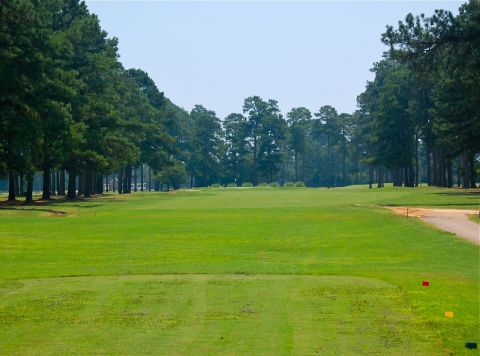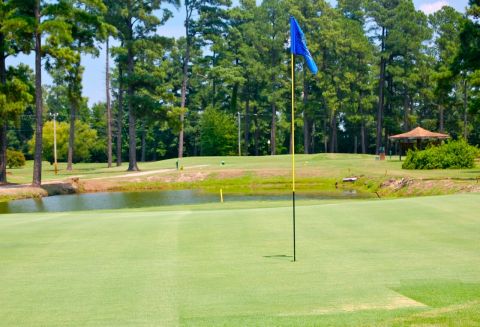Lumberton, NC, is not really on anybody’s radar as a golf destination or, for that matter, a destination of other note. The city’s own official web site mentions only the Lumber River as a noteworthy part of the city’s history –- no major event, no economic driver like tobacco or textiles, just
Later, another noted golf course designer, Dick Wilson, was called in to bring harmony to the older and new nines. The golf course toddled along through the following decades until the latest recession hit it hard and convinced the local foundation to put it up for sale. To know Pine Crest, apparently, is to believe its best days lie ahead; the purchasers of the golf club earlier this year were its golf professional and superintendent, Dwight Gane and Chris Jackson, who have worked at the course for a combined 20 years.

True to its name, most of the fairways at Pine Crest are lined with pines, as at the 413 yard par 4 16th, rated the toughest hole on the golf course.
My golf-in-the-south buddy Bob and I stopped at Pine Crest recently for a round on an extremely hot day. Although the typically crowned Rossian greens and ample collection areas were in strong evidence, our major disappointment was that the greens were like mohair, no fun at all to putt. I found myself welcoming approach shots that just missed the greens so that I could have a go at chipping up and over false fronts and bunkers or hitting the occasional bump and run shot: Anything to avoid a long putter backswing on putts of 30 feet or more.
Golf pro Gane indicated that, despite my assumption his partner the superintendent was being skittish about cutting the greens too short, it was actually the heat and sun that was promoting the rapid grass growth that made the greens so shaggy. Whatever, the putting surfaces made me long for a return trip in late fall or early winter when, the pro indicated, the greens will stimp (roll on the stimpmeter) at around 10, about medium fast. That should be fun.


The narrow 8th hole at Pine Crest is a seemingly unremarkable and short par 5 (450 yards from the back tees). The only trouble off the tees (top photo) are the pine trees and a fairway bunker on the left. The fun begins at the green, which presents itself like a dented upside-down frying pan.
Other than the greens, we found the fairways typically generous, as Ross tends to be, and the changes Dick Wilson made to the golf course were utterly harmonious. Before our round, pro Gane indicated for us which greens were credited to Ross and which to Wilson and, to be honest, there was no apparent difference. They all seemed to embody the customary Ross touches -– the crowned surfaces, the smallish sizes, bunkering protecting the flatter areas of the greens.
Golfing foursomes heading from the northeast to a week’s golfing vacation in Myrtle Beach might consider taking that Lumberton exit off the interstate, just five minutes from Pine Crest Country Club, for a little warm-up round and a walk through history. Just do it when the weather is cool and the green superintendent throws caution –- and grass clippings –- to the wind.


Water comes into play most effectively on the Pine Crest golf course at the par 3 12th (top) and on the approach to the par 4 13th.
Pine Crest Country Club, which first opened in 1929, is located at 110 Nigel Drive in Lumberton, NC, just five minutes from Interestate 95. From the tips, it plays only to 6,578 yards with a rating of 71.1 and slope of 123. Its design is credited to both Donald Ross and Dick Wilson. The pro shop is at 910-738-6541. Green fees are incredibly reasonable; we paid just $25 each, with cart (although the course is a flat and easy walk, if you are disposed to the extra exercise). The golf course, which is open year round, is best played in the cooler months when the greens roll faster. Pine Crest can certainly be a stimulating and economical stop for serious golfers traveling down the interstate toward a Myrtle Beach golf vacation.



